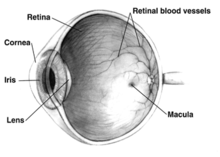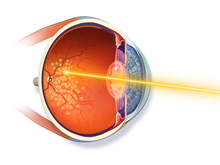
Familial exudative vitreoretinopathy (FEVR, pronounced as fever) is a genetic disorder affecting the growth and development of blood vessels in the retina of the eye. This disease can lead to visual impairment and sometimes complete blindness in one or both eyes. FEVR is characterized by incomplete vascularization of the peripheral retina. This can lead to the growth of new blood vessels which are prone to leakage and hemorrhage and can cause retinal folds, tears, and detachments. Treatment involves laser photocoagulation of the avascular portions of the retina to reduce new blood vessel growth and risk of complications including leakage of retinal blood vessels and retinal detachments.
Information
Pathophysiology
FEVR is caused by genetic defects involving the regulation of blood vessel growth in developing eyes. As a result, there is poor blood vessel growth to the periphery of the retina. The lack of blood supply to the peripheral retina triggers the release of molecules that stimulate blood vessel growth, such as vascular endothelial growth factor (VEGF). However, this new blood vessel growth, also known as neovascularization, can lead to further complications such as the leakage and hemorrhage of retinal blood vessels, retinal tears, and detachments.
Genetics
There have been several gene mutations associated with FEVR. These genes code for proteins involved in the WNT signaling pathway, which is involved in the development of the human eye and regulation of blood vessel growth. Depending on the genes involved, FEVR can follow an autosomal dominant, autosomal recessive, or X-linked inheritance pattern. There is varying penetrance and expressivity depending on the genes involved. While genetic testing may be useful in the diagnosis of FEVR, a negative genetic test does not rule out the disease.
Diagnosis

Diagnosis of FEVR is often made through direct visualization of the retina and fluorescein angiography, along with personal and family medical history. Hallmark characteristics of FEVR include lack of blood vessels in the peripheral retina. Other findings may include vessel and macular dragging, sub-retinal exudates, neovascularization, retinal folds, and retinal detachments. FEVR must be differentiated from other diseases involving incomplete vascularization of the retina including retinopathy of prematurity (ROP), Norrie disease, Coat's disease, and others. Severity of disease is highly variable and can range from mild visual impairment to complete vision loss. Based on the severity of the disease, FEVR is diagnosed based on a clinical staging scale from 1 to 5. Since FEVR often runs in families, immediate relatives of someone diagnosed with FEVR should be examined by an ophthalmologist because the disease can have no symptoms before complications arise including retinal detachments.
Treatment
Treatment is largely aimed at reducing the amount of new blood vessel growth and preventing complications that may arise as a result, including retinal tears and detachments. Using a laser, an ophthalmologist burns the portions of the retina that are not supported by blood vessels, a technique known as laser photocoagulation. By doing so, this tissue will no longer release molecules that stimulate blood vessel growth. If a retinal detachment occurs, laser therapy or surgery may be required to repair the retina.

References
- ^ "Familial Exudative Vitreoretinopathy (FEVR) - EyeWiki". eyewiki.aao.org. Retrieved 2021-12-31.
- ^ Sızmaz, Selçuk; Yonekawa, Yoshihiro; Trese, Michael T. (2015-08-05). "Familial Exudative Vitreoretinopathy" (PDF). Türk Oftalmoloji Dergisi. 45 (4): 164–168. doi:10.4274/tjo.67699. PMC 5082275. PMID 27800225.
- ^ Tauqeer, Z.; Yonekawa, Y. (2018). "Familial Exudative Vitreoretinopathy: Pathophysiology, Diagnosis, and Management". Asia-Pacific Journal of Ophthalmology. 7 (3): 176–182. doi:10.22608/APO.201855. PMID 29633588. S2CID 4720368.
- ^ Gilmour, D F (January 2015). "Familial exudative vitreoretinopathy and related retinopathies". Eye. 29 (1): 1–14. doi:10.1038/eye.2014.70. ISSN 0950-222X. PMC 4289842. PMID 25323851.
External links
| Classification | D |
|---|---|
| External resources |
- GeneReviews/NCBI/NIH/UW entry on Familial Exudative Vitreoretinopathy, Autosomal Dominant
- NCBI Genetic Testing Registry
| Congenital malformations and deformations of eyes | |||||||||||||||
|---|---|---|---|---|---|---|---|---|---|---|---|---|---|---|---|
| Adnexa |
| ||||||||||||||
| Globe |
| ||||||||||||||
| Cell membrane protein disorders (other than Cell surface receptor, enzymes, and cytoskeleton) | |||||||||||
|---|---|---|---|---|---|---|---|---|---|---|---|
| Arrestin | |||||||||||
| Myelin | |||||||||||
| Pulmonary surfactant | |||||||||||
| Cell adhesion molecule |
| ||||||||||
| Tetraspanin | |||||||||||
| Other | |||||||||||
| See also other cell membrane proteins | |||||||||||